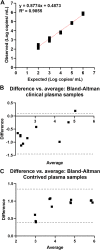Respiratory Adenovirus Quantification with a Droplet Digital Polymerase Chain Reaction (ddPCR) Assay
- PMID: 37070988
- PMCID: PMC10269445
- DOI: 10.1128/spectrum.00269-23
Respiratory Adenovirus Quantification with a Droplet Digital Polymerase Chain Reaction (ddPCR) Assay
Abstract
Human adenoviruses (HAdVs) are double-stranded DNA viruses that can cause a wide spectrum of disease, including respiratory infections. Little is known about the value of respiratory HAdV quantification and its correlation with disease severity. In this study, we developed a quantitative HAdV droplet digital PCR (ddPCR) assay to study the association between viral loads, circulating types, and clinical outcomes. Remnant respiratory specimens positive for HAdV after the standard of care testing were collected from December 2020 to April 2022. A total of 129 samples were tested by a ddPCR method. Typing was performed using Nanopore sequencing of the hexon gene hypervariable region. Clinical chart reviews were performed to correlate the viral loads with the disease severity. The ddPCR assay showed an analytical sensitivity and a lower limit of quantification below 100 copies/mL. Of 129 positive clinical samples, 100 were quantified by ddPCR, 7 were too concentrated to be quantified, and 22 were negative. Of the 22 false negatives, only 3 were successfully typed; however, 99 of the 107 positive samples had a characterized genotype. The main HAdV types identified in this cohort were C1 (49.5%) followed by C2 (34.3%). No significant difference in HAdV loads was noted between patients who were admitted, those who required supplemental oxygen, and outpatients or between different HAdV types. HAdV ddPCR is a reliable absolute quantification approach for HAdV from respiratory samples. HAdV loads at initial presentation does not appear to differ between patients who require hospitalization versus outpatients. IMPORTANCE Measuring viral load using droplet digital PCR (ddPCR) is an absolute quantification approach that can facilitate comparability between different laboratories. This approach could prove valuable in studies that focus on the clinical utility of quantification. In this study, we evaluate a human adenovirus (HAdV) ddPCR assay and study the relationship between viral loads and outcomes after HAdV respiratory infections.
Keywords: adenovirus; ddPCR; droplet digital PCR.
Conflict of interest statement
The authors declare a conflict of interest. H.M. received CME honorarium from Roche. H.M. has research collaborations with BioRad, Roche, and Hologic.
Figures



References
-
- Heim A, Hayden RT. 2014. Adenoviruses, p 1831–1839. In Manual of clinical microbiology, 12th ed, ASM Press, Washington, DC. doi: 10.1128/9781683670438.MCM.ch106. - DOI
Publication types
MeSH terms
Grants and funding
LinkOut - more resources
Full Text Sources
Miscellaneous

